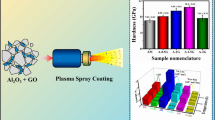Abstract
Despite the broad field of applications for active filler alloys for brazing ceramics, as well as intense research work on the wetting and spreading behavior of these alloys on ceramic surfaces within the last decades, the manufactured joints still exhibit significant variations in their properties due to the high sensitivity of the alloys to changing brazing conditions. This increases the need for investigations of the wetting and spreading behavior of filler alloys with regard to the dominating influences combined with their interdependencies, instead of solely focusing on single parameter investigations. In this regard, measurements of the wetting angle and area were conducted at solidified AgCuTi and CuSnTi alloys on SiC substrates. Based on these measurements, a regression model was generated, illustrating the influence of the brazing temperature, the roughness of the faying surfaces, the furnace atmosphere, and their interdependencies on the wetting and spreading behavior of the filler alloys. It was revealed that the behavior of the melts was significantly influenced by the varied brazing parameters, as well as by their interdependencies. This result was also predicted by the developed model and showed a high accuracy.








Similar content being viewed by others
References
M.G. Nicholas, S.D. Peteves, Scripta Metall. Mater., 1994, vol. 31, pp. 1091-96.
W. Tillmann: PhD Thesis, RWTH-Aachen, 1992.
B. Drevet, S. Kalogeropoulou, N. Eustathopoulos, Acta Metall. Mater., 1993, vol. 41, pp. 3119-26.
A.G. Pincus, S. Chang, Am. Ceram. Soc. Bull., 1977, vol. 56, pp. 433-36.
A.P. Tomsia, J.A. Pask, R.E. Loehman, S.M. Johnson, Ceram. Eng. Sci. Process., 1989, vol. 10, pp. 1631-54.
X.B. Zhou, J.Th.M. de Hosson, Acta Mater., 1995, vol. 44, pp. 421-26.
J.C. Ambrose, M.G. Nicholas, A.M. Stoneham, Acta Metall. Mater., 1992, vol. 40, pp. 2483-88.
L. Ljungberg: PhD Thesis, Chalmers University of Technology in Gotheburg, 1992.
V.S. Zhuravlev, A.A. Prokopenko, B.D. Kostyuk, I.I. Gab, and Y.V. Naidich: Proceedings of the International Conference on High Temperature Capillarity, 1998, pp. 299–305.
K. Landry, C. Rado, R. Voitovich, N. EustathopoulosActa Mater., 1997, vol. 45(7), pp. 3079-85.
P. Xiao, B. Derby, Acta Mater., 1998, vol. 46(10), pp. 3491-99.
Y.V. Naidich, V.S. Zhuravlev, N. Krasovskaya, Mater. Sci. Eng. A 1998,vol. A245, pp. 293-99.
J. Drelich, J.D. Miller, J. Colloid Interface Sci., 1993, vol. 164, pp. 252-59.
C. Rado, S. Kalogeropoulou, N. Eustathopoulos, Scripta Mater., 1999, vol. 42(2), pp. 203-08.
KH. Xiong, X. Li, W. Mao, Y. Cheng, Mater. Lett., 1997, vol. 57, pp. 3417-21.
D. Ashoff: PhD Thesis, TU Dortmund, 1994.
W. Tillmann, J. Pfeiffer, N. Sievers, R. Zielke, L. Wojarski, Keram. Z., 2011, vol. 3, pp. 180-85.
N. Eustathopoulos, M.G. Nicholas, and B. Drevet: Wettability at High Temperatures, 3rd ed., Pergamon Materials Series, New York, 1999.
R. Asthana, N. Sobczak (2000) JOM-e 52, 1–19.
P.G. de Gennes, Rev. Mod. Phys., 1985, vol. 57, pp. 827-63.
W.D. Kaplan, D. Chatain, P. Wynblatt, W.C. Carter, J. Mater. Sci., 2013, vol. 48, pp. 5681-5717.
T. Young, Trans. R. Soc., 1805, vol. 95, pp. 65-87.
N. Sobczak, M. Singh, R. Asthana, Curr. Opin. Solid State Mater. Sci., 2005, vol. 9, pp. 241-53.
P.G. de Gennes, F. Brochard-Wyart, D. Quere, Capillarity and Wetting Phenomena, 1st ed., Springer, New York, 2004.
G. Kumar, K.N. Prabhu, Adv. Colloid Interface Sci., 2007, vol. 133, pp. 61-89.
P.R. Chidambaram, A. Meier, G.R. Edwards, Mater. Sci. Eng., 1995, vol. A206, pp. 249-64.
N. Eustathopoulos, N. Sobczak, A. Passerone, K. Nogi, Mater. Sci. Eng., 2005, vol. 40, pp. 2271-80.
S. Kalogeropoulou, C. Rado, N. Eustathopoulos, Scripta Mater., 1999, vol. 41, pp. 723-28.
L. Espie, B. Drevet, N. Eustathopoulos, Metall. Mater. Trans. A, 1994, vol. 25, pp. 599-605.
R.N. Wenzel, Ind. Eng. Chem., 1936, vol. 28, pp. 988-94.
A.B.D. Cassie, S. Baxter, Trans. Faraday Soc., 1944, vol. 40, pp. 546-51.
F.G. Yost, J.R. Michael, E.T. Eisenmann, Acta Metall. Mater., 1995, vol. 43, pp. 299-305.
S.J. Hitchcock, N.T. Caroll, M.G. Nicholas, J. Mater. Sci., 1981, vol. 16, pp. 714-32.
W. Tillmann, J. Pfeiffer, L. Wojarski, and S. Yurchenko: Proceedings of the International Conference Brazing, High Temperature Brazing and Diffusion Welding, 2013, vol. 10, pp. 151–56.
W. Tillmann, J. Pfeiffer, L. Wojarski, M. Bruns, and H.G. Rademacher, Oberflächenbehandlung zum Fügen von keramischen Werkstoffen, Technische Keramische Werkstoffe, Chap. 3.9.2.1, HVB, Ellerau, 2013.
Acknowledgments
This research was supported by the German Research Foundation (DFG Grant No.: TI-343/52-1, “In-Situ” Untersuchungen des Einflusses der Oberflächengüte und Interface-Reaktionen auf das Benetzungsverhalten verschiedener Lotsysteme auf Siliziumkarbid am GK-REM), Germany.
Author information
Authors and Affiliations
Corresponding author
Additional information
Manuscript submitted October 21, 2014.
Rights and permissions
About this article
Cite this article
Tillmann, W., Pfeiffer, J. & Wojarski, L. The Apparent Contact Angle and Wetted Area of Active Alloys on Silicon Carbide as a Function of the Temperature and the Surface Roughness: A Multivariate Approach. Metall Mater Trans A 46, 3592–3600 (2015). https://doi.org/10.1007/s11661-015-2938-9
Published:
Issue Date:
DOI: https://doi.org/10.1007/s11661-015-2938-9




